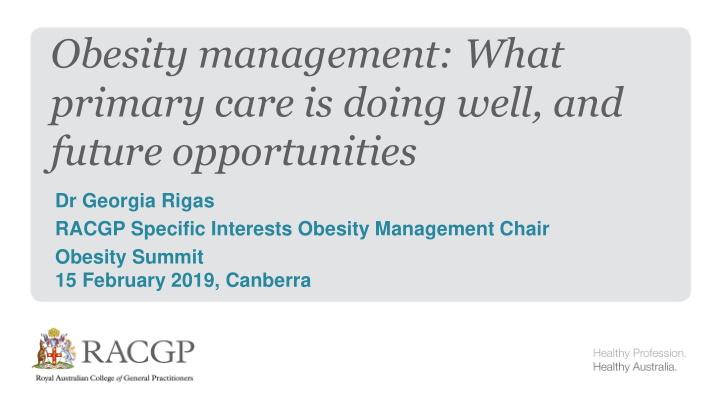



Obesity management: What primary care is doing well, and future opportunities Dr Georgia Rigas RACGP Specific Interests Obesity Management Chair Obesity Summit 15 February 2019, Canberra
Every week, over 2 million Australians visit a GP GPs deal with individuals day to day; therapeutic relationship of trust, rapport etc Primary care often has a deep understanding of the individual’s circumstances & the communities they work in GPs are well placed to intervene at key times in an individual’s life
RACGP Red Book 9 th edition Measure waist circumference (WC) and calculate BMI: • every 2 years in all patients (screening) • annually for adults: – with diabetes, CVD, stroke, gout, liver disease, or – from high risk groups (eg Aboriginal, Torres Strait, Pacific Islands) • every 6 months for those with overweight or obesity
As GPs we need to do more Turner et al MJA 2015 study found that: • 22.2% of pts had BMI documented • 4.3% of pts had WC documented If we’re not measuring it, how can we diagnose & treat it?
General practice activity in Australia 2015-16: Bettering the evaluation and care of health (BEACH): • 2.6% of total “problems” dealt with in consultations related to diabetes; Only 0.5% related to obesity HOWEVER • approximately 6% of the population has diabetes (excluding GDM, according to ABS (2014-15) on self reported data) cf 28% adult population having obesity (AIHW 2018)
People with class III (previously morbid) obesity Prevalence of severe obesity ie BMI ≥40, has almost doubled in last 15 years
Aboriginal and Torres Strait Islanders The prevalence of obesity in Aboriginal and Torres Strait Islander communities is alarming. Obesity is thought to contribute to 16% of the health gap between Aboriginal and Torres Strait Islander people and the total Australian population. The inequity in health service access provision for Australians with obesity is further accentuated in those from Aboriginal and Torres Strait Islander communities Australian Health Ministers’ Advisory Council. Aboriginal and Torres Strait Islander Health Performance Framework 2014 Report. Canberra: AHMAC 2015
Healthy communities: Rates of overweight and obesity across Australia, 2014-15 • The number of individuals with overweight or obesity is over represented in rural and remote areas of Australia • In the scope of health service provision for obesity management, these areas are often under-serviced and under-resourced , further exacerbating the inequity between the two
Change the weight gain trajectory Make a difference for the individual, but also the next generation Prevent +/- defer onset of complications and comorbidities of obesity Magarey AM, Perry RA, Baur et al. A parent-led family-focused Sjöström L, Peltonen M, Jacobson P et al. Bariatric surgery and long- treatment program for overweight children aged 5 to 9 years: The term cardiovascular events . JAMA. 2012;307(1):56 – 65 PEACH RCT. Pediatrics. 2011;127(2):214-22.
Medical and surgical induced weight loss: Importance of aftercare Achieve optimal health benefit from therapy Ongoing delivery of education and support to patient and their carer Prevention of or early diagnosis of complications
Ongoing education of patient and carers Reduce stigma Increased access to treatment and support services Improved patient outcomes It is very difficult to lose weight once an individual has developed obesity
A Clinician’s perspective Discrimination and weight bias even amongst HCPs Time constraints- remember doesn’t have to be done in one consult* Fear of billing too many “long consults” and possible ramifications *Forgione N, Deed G, Kilov G, Rigas G. Adv Ther. 2018;35(2):191 – 198. Managing obesity in primary care: Breaking down the barriers.
GP Management Plan (GPMP) Chronic medical condition or terminal illness that has been (or is likely to be) present for six months or longer Patients require ongoing care from a multidisciplinary team
NHMRC Guidelines June 2013 ≈16kg ≈20kg ≈40kg
Current initiatives RACGP: Obesity Position statement on prevention and treatment of obesity SI Obesity Management Network The Obesity Collective Healthy Heart Partnership Shaping a healthy Australia pilot project Better access to public bariatric metabolic surgery taskforce Supporting the Senate Obesity Enquiry final report December 2018, Canberra
What we need? • GPs need to be supported to provide effective, evidence-based management to patients with obesity. • There needs to be clarity about what MBS supported services people with obesity are entitled to access and more support in place; this includes clarification on use of chronic care plans • Better access to public obesity clinics and/or bariatric services, in particular in regional areas, with easily identifiable entry criteria
What do we want? • Greater education and support of practicing GPs and also GP registrar training • Shared care pathways • Greater remuneration for the longer consults required when dealing with the complexity of obesity and its complications and comorbidities
Take home messages 1. Commit to using people first language and to ending the use of stigmatising images and messages. 2. Re- think “failure” as it adds to stigma/shame 3. GPs are well placed to intervene at various critical time points in an individual’s life 4. Clinician’s mantra: “measure, identify, treat”
Recommend
More recommend